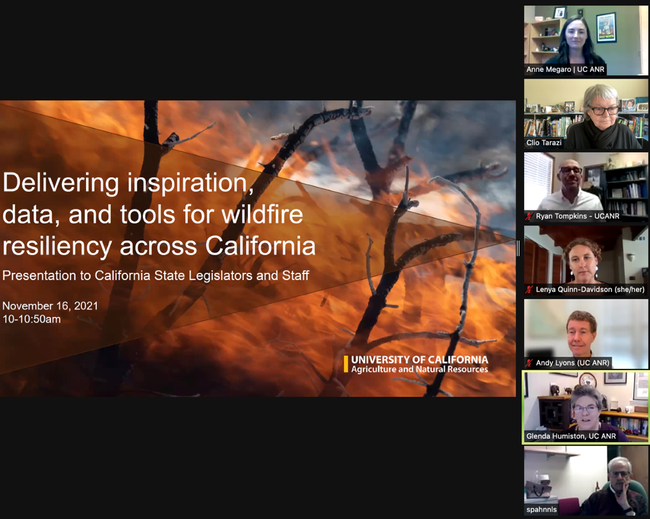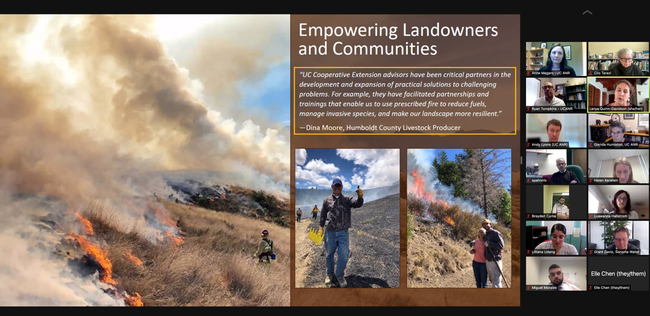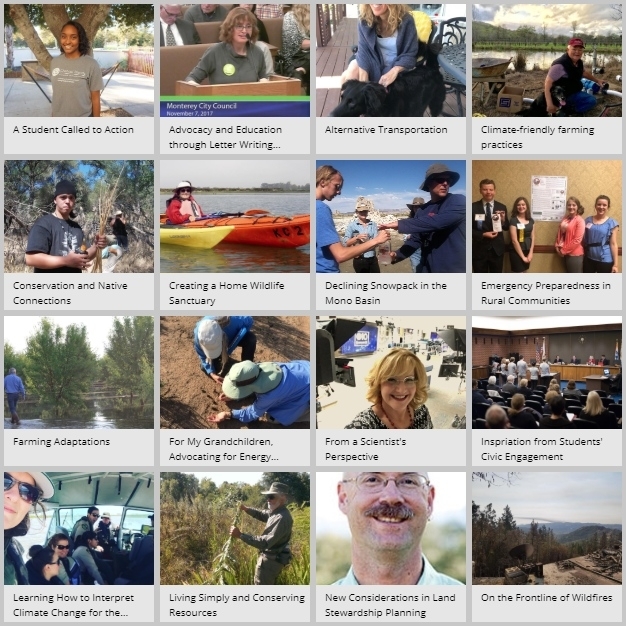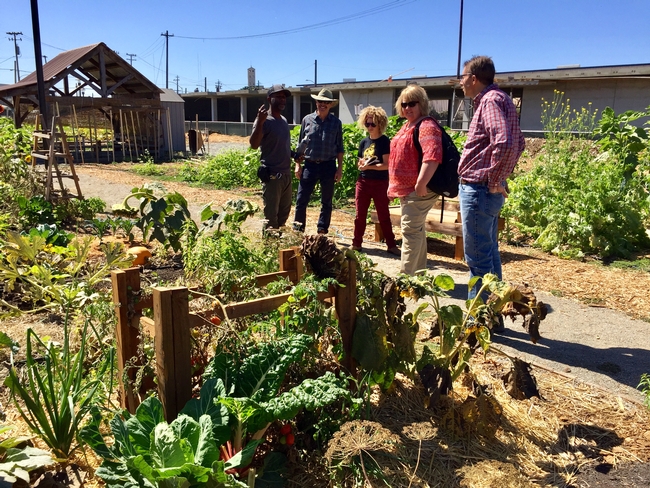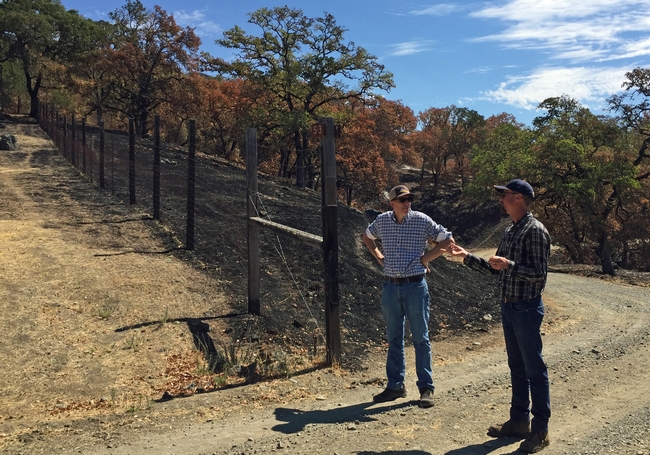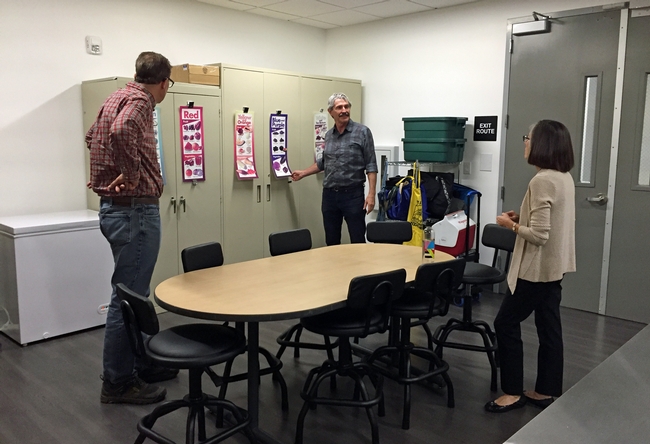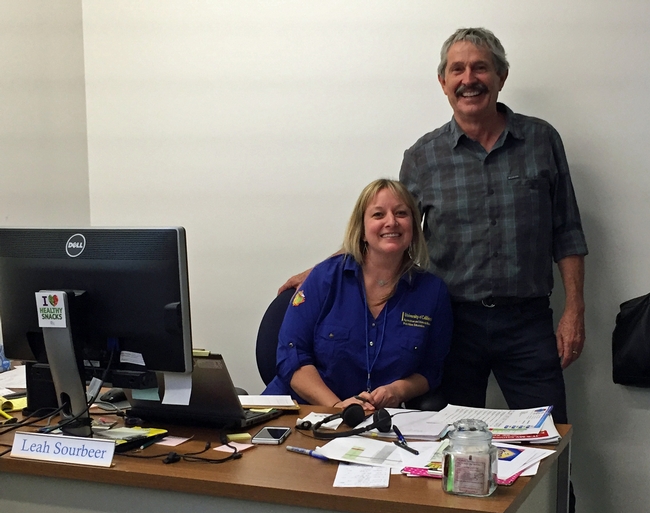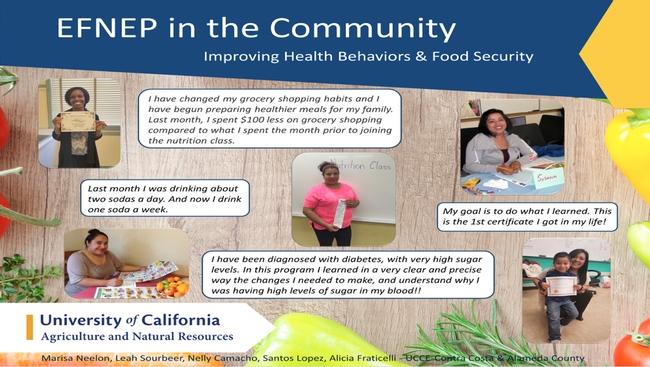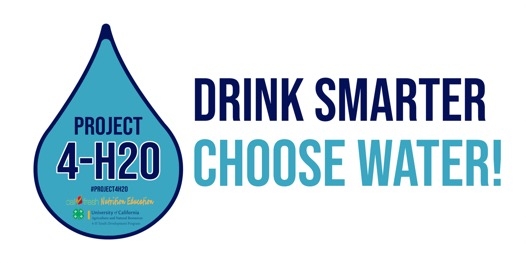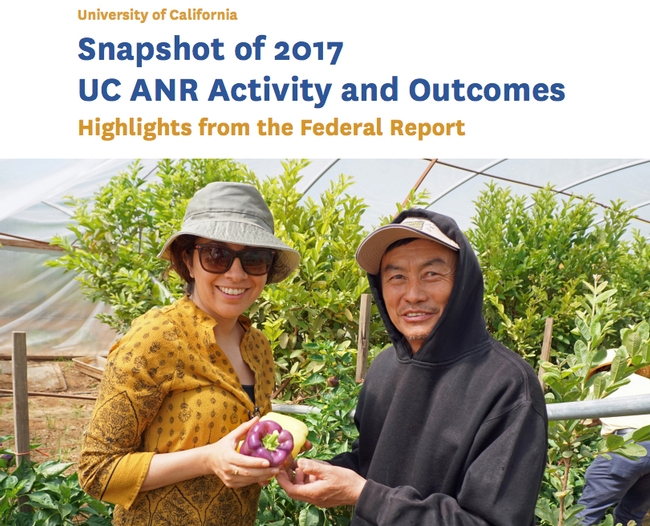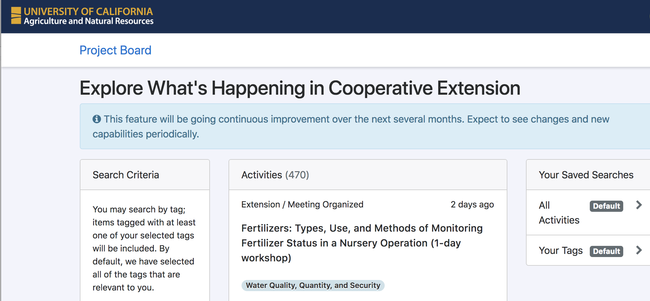Posts Tagged: Andy Lyons
Legislative staff attend virtual wildfire tour
UC ANR hosted a wildfire virtual tour for state legislators, legislative staff and agency officials Nov. 16. Vice President Glenda Humiston introduced the UC Cooperative Extension advisors, a program coordinator and a Master Gardener volunteer who shared real-world examples of how UC research and tools are helping Californians prepare for and mitigate wildfires in their homes, communities, and wildlands.
Fourteen legislative and agency staff members joined the virtual morning tour across California's landscapes.
Ryan Tompkins, UC Cooperative Extension forest and natural resources advisor, discussed his forest management research and shared photos of live fires – some taken from his own front yard this year. Andy Lyons, Informatics and GIS program coordinator, showed them tools such as drone imagery and mapping that can be used in real time to fight fires.
Clio Tarazi, UC Master Gardener volunteer and retired urban planner who helped UC ANR pioneer defensible space training and Firewise Landscaping in Sonoma County, described how UC Master Gardeners worked one on one with residents, helping them reduce fire risk around their homes and neighborhoods.
Lenya Quinn-Davison, UCCE fire advisor, discussed her work with prescribed fire, training women and people from other underrepresented groups in fire careers (WTREX), and bringing together non-traditional partners to build capacity to improve fire resiliency.
“Inviting legislators and their staff to witness the work we do hand-in-hand with their constituents is critical to making informed policy,” said Humiston. “Wildfire resiliency is of utmost importance, and UC has the tools and expertise to build California's capacity to prevent and reduce the damage from catastrophic wildfires. No matter where you live in California, wildfire affects all of us.”
For guests who expressed interest in seeing a live prescribed burn, Anne Megaro, director of government and community relations, is arranging visits.
California Adaptation Clearinghouse website launched
IGIS and the California Naturalist Program are pleased to help celebrate the launch of a new information portal on climate adaptation. The California Adaptation Clearinghouse was officially launched at the California Adaptation Forum in August in Sacramento. The site was developed by the Governor's Office of Planning and Research (OPR) in collaboration with the UC Berkeley Geospatial Innovation Facility, CalNat and IGIS.
The Clearinghouse is a database-driven platform with a wealth of curated resources for climate adaptation. The site originated out of Senate Bill 246, which mandates OPR to provide resources on climate adaptation for local governments, regional planning agencies, and other practitioners working on adaptation and resilience. The database also contains sea-level rise resources collected by the Ocean Protection Council under Assembly Bill 2516. It's an amazing resource for anyone looking to strengthen climate change preparedness in their local government, community, or business.
The database includes numerous planning resources that have been developed and vetted by experts in the field. For example, the Urban Sustainability Directors Network has a how-to guide for local governments on developing equitable, community-driven climate preparedness plans, which you can find in the Clearinghouse. There are also examples of vulnerability assessments, local plans, and funding strategies. The majority of resources are hosted by other organizations, but unlike a Google search all the resources in the Clearinghouse have been reviewed, annotated, and cataloged by subject matter specialists.
To help find resources, the Clearinghouse has a number of search options, including more than a dozen topic categories adapted from Safeguarding California, the state's overall roadmap for building climate change resiliency. You can also search by Type of Impact (e.g., drought, sea level rise), Resource Type (e.g., case study, assessment, policy guidance), and of course an interactive map. Each resource has a descriptive blurb so you can quickly find what you need.
Adaptation planning can be information intensive, so the Tools and Data section of the website is devoted to helping people find data and crunch the numbers. Interested in rangelands? Check out the CA Landscape Conservation Cooperative's compiled Threat Assessments to California Rangelands. Sea level rise? Perhaps the CosMos modeling tool from USGS, or the Surging Seas tool from Climate Central. Like all resources, each tool and dataset has a user-friendly description, a technical summary, a bit about the data, and links to the source. One of our favorites is the California Energy Commission's Cal-Adapt, which includes both historical and projected climate data downscaled for California.
Providing a more personal perspective, the Clearinghouse also contains stories about climate adaptation from individuals, community groups, and businesses. The stories were collected by the UC ANR California Naturalist Program and their vast network of certified naturalists. The climate stories are diverse and compelling, from a concerned grandmother who becomes engaged in a community choice energy program, to a solar project engineer working to strengthen measures to prevent heat stroke in field staff. An interactive Story Map developed by IGIS helps users find stories from their area, some of which even have audio or video clips so you can hear the story in the speaker's own words.
Climate adaptation is complicated, but information portals like the Clearinghouse allow anyone to tap into the incredible amount of work that has already been done in California and elsewhere. Rather than reinvent the wheel, local agencies can build upon vetted guidelines from similar areas. We are all fortunate that the State of California has invested in a platform to share curated resources for the long-term, because climate adaptation is already part of the new normal. More resources are in the pipeline, so check it out and then check back often to see what's new.
RECs and county office staff update ANR leaders on current projects
To get acquainted with the people at each ANR location, Mark Lagrimini, vice provost of research and extension, has been visiting research and extension centers and UCCE county offices and touring the facilities.
“I'm impressed with how passionate and dedicated you are to helping people,” said Lagrimini to UCCE Contra Costa staff after listening to their project updates. He has been impressed with the work he has seen at all of his ANR visits.
On Sept. 6, Lagrimini visited Hopland Research and Extension Center, three weeks after the River Fire consumed about two-thirds of its property.
“While the River Fire damaged parts of the center, none of the main buildings, residences, livestock nor staff were hurt by the fire,” said John Bailey, Hopland REC interim director.
Scientists are invited to a site tour on Oct. 19 to learn more about research opportunities at Hopland REC.
“With Hopland REC's extensive pre-fire historical data, plus immediate post-fire, pre-rain observations that we are collecting, we have the foundation to support relevant and timely research on the effects of fire and mechanisms of recovery,” Bailey said.
AVP Wendy Powers and Mark Bell, vice provost of Strategic Initiatives and Statewide Programs, are joining Lagrimini for many of the visits to learn the latest about UCCE research and outreach and to answer questions from staff.
On Sept. 11, Rob Bennaton, UCCE director in Alameda and Contra Costa counties, introduced Powers, Lagrimini and Bell to UCCE staff in their Hayward offices, then took them to West Oakland to tour City Slicker Farms. UCCE Master Gardeners and 4-H members partner with City Slicker Farms, teaching people how to grow food at the site.
“Success to us is putting food where people need it and giving them the skills to grow food,” said Rodney Spencer, executive director of City Slicker Farms.
In Concord, Marisa Neelon, UCCE nutrition, family and consumer sciences advisor in Contra Costa County, gave Powers, Lagrimini and Bell a tour of the new office space, which includes space for Master Garden volunteers, a kitchen for nutrition educators to prepare food and a lab for farm and IPM advisors to store and analyze samples.
Staff from each unit delivered a presentation about their current projects for the ANR leaders, who were joined by Humberto Izquierdo, agricultural commissioner for Contra Costa County and Matthew Slattengren, assistant agricultural commissioner.
Charles Go, 4-H youth advisor, and Adan Osoria, EFNEP community nutrition educator, described how 4-H and EFNEP teamed up for 4-H2O, an after school project aimed at reducing consumption of sugar-sweetened beverages and increasing water consumption to improve community health and wellness. They launched 4-H2O at John Swett High School in Crockett. At the request of 4-H members, the local school board approved hydration stations and instructed the schools to provide water at meal times, Go said.
Andrew Sutherland, Bay Area urban IPM advisor, described his research on baiting for cockroaches, subterranean termites and yellowjackets and outreach to educate pest control professionals to practice IPM in schools and multi-unit housing.
“I appreciate the work Andrew does,” said Izquierdo, noting that there is a need for pest management education, especially among the county's urban and immigrant populations.
After seeing all of the presentations, Bell said, “The enthusiasm you bring to your job is inspiring.”
After the visit, Powers wrote in her ANR Adventures blog on Sept. 14: “The programs we've seen in Contra Costa and Alameda Counties this week as well as Santa Clara County a couple weeks back are good reminders of the benefits to all of UC ANR when we have strong, relevant programs in urban areas. These programs not only help the clientele, directly, but help increase the visibility of UC ANR and all of its programs across both urban and ag areas.”
On Sept. 26, Powers, Lagrimini and Bell visited UCCE Riverside, then UCCE San Bernardino the following day.
“We spent yesterday in Riverside meeting with the teams from both UCCE Riverside and UCCE San Bernardino,” Powers wrote in ANR Adventures on Sept. 27. “It was very informative, particularly seeing the fresh ideas that are coming from some of the new staff. We were able to hear about the tremendous success that both counties are having truly working as a team across program areas and layering their efforts for increased program success and support.”
Federal Report Snapshot highlights ANR accomplishments
Each spring, the UC ANR Office of Program Planning and Evaluation (PPE) compiles and submits a report to our federal funding partner, USDA's National Institute of Food and Agriculture (NIFA). In August, NIFA approved UC ANR's 2017 report.
A snapshot of the 2017 UC ANR Federal Report is available at the following link: https://ucanr.edu/sites/anrstaff/Divisionwide_Planning. The snapshot highlights several dozen examples of research and extension occurring in each Strategic Initiative and in the field of sustainable energy. The Federal Report Snapshot can be shared with stakeholders and potential donors to help them better understand the breadth of projects and range of impacts that occur throughout ANR in a given year.
The full report that was submitted to NIFA captures the annual activities, outputs, and outcomes that occur throughout ANR as a result of NIFA funding on campuses, in counties and at the research and extension centers.
Information for the report comes from submissions entered in REEport, DANRIS-X (now replaced by Project Board for FY 2018 and on), and UC Delivers. Content experts identify the most significant research highlights and write the program area narrative summaries. This year we want to thank Chris Greer, Cheryl Wilen, Keith Nathaniel, John Harper, Doug Parker and Jeff Dahlberg. Because the report is thorough and lengthy, PPE has created this condensed snapshot, which is drafted with input from Communications Services.
Both the snapshot and full report are available at https://ucanr.edu/sites/anrstaff/Divisionwide_Planning.
Project Board integrates reporting and may facilitate collaboration
Project Board is a new online system that integrates ANR academic program review, civil rights compliance, and accountability reporting requirements. It also has search features that may facilitate collaboration and support advocacy efforts. Project Board launched on May 3, 2018, for academics who have ANR merit + promotion, and on July 31, 2018, for CE specialists whose merit + promotion packages are processed by a campus.
Project Board will be searchable by keyword by all ANR staff and academics to find projects. Only CE academics are required to enter information into the system. New features, bug fixes and help text are being continuously rolled out. Project Board works best on Firefox and Chrome web browsers.
Goodbye DANRIS-X!
Reporting for the federal fiscal year that began Oct. 1, 2017, and ends Sept. 30, 2018, is required in Project Board for all Cooperative Extension academics. Training information and technical assistance Zoom hours can be found on this webpage. DANRIS-X is closed for data entry but will remain open for retrievals and reports.
For more information:
- Visit Project Board Help: http://ucanr.edu/sites/ProjectBoardHelp/
- Academic Human Resources questions, contact Kim Ingram at kcingram@ucanr.edu
- Civil Rights Compliance/Affirmative Action questions, contact David White at dewhite@ucanr.edu
- General Project Board and Program Planning and Evaluation questions, contact Kit Alviz at kit.alviz@ucop.edu or Chris Hanson at Christopher.hanson@ucop.edu

